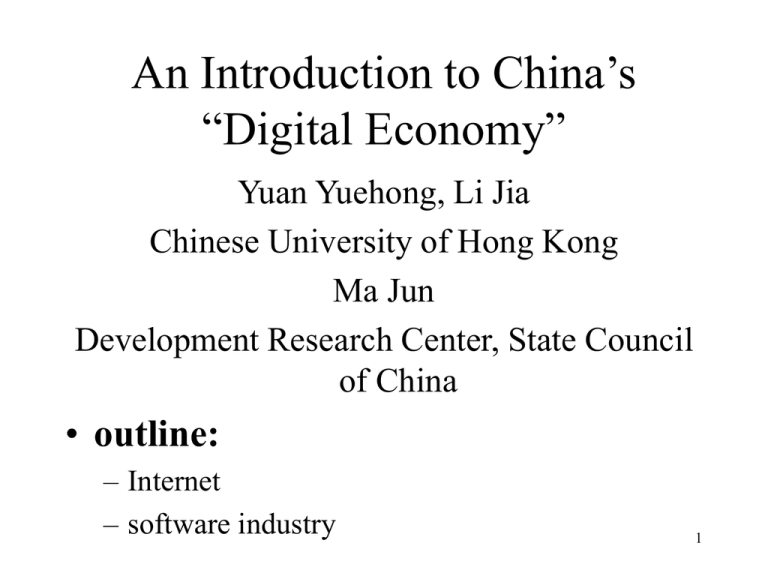tokyo presentation (Yuan).ppt
advertisement

An Introduction to China’s “Digital Economy” Yuan Yuehong, Li Jia Chinese University of Hong Kong Ma Jun Development Research Center, State Council of China • outline: – Internet – software industry 1 Number of Internet Users (12/99) Country Users (1000) China is % of penetration U.S. 110,825 9% 40.65% Japan 18,156 54% 14.39% U. K. 13,975 70% 23.64% Canada 13,277 74% 42.82% Germany 12,285 80% 14.97% China 8,900 100% 0.71% Australia 6,837 143% 36.40% Brazil 6,790 144% 3.95% Korea 5,688 172% 12.13% Taiwan 4,790 205% 21.66% China's # by CNNIC Other #s by Computer Industry Almanac, as cited by sina.com http://tech.sina.com.cn/news/internet/2000-01-05/14751.shtml China's # is 6,308, 000 according to Computer Industry Almanac. Total population from CIA fact book, http://www.cia.gov/cia/publications/factbook/country.html 2 Semi-annual Internet Growth Time 12/31/99 6/31/99 12/31/98 30/06/98 Computers users Int'l Online (million) web site # bandwidth 3500 9.8 15153 351 1460 4 9906 241 747 2.1 5300 143 542 1.2 3700 85 Registered domain name in 12/99: 48695 Source: CNNIC 3 Semi-annual Growth Rates Time 12/31/99 6/30/99 12/31/98 Computers online 140% 95% 38% users web sites 145% 53% 90% 87% 75% 43% Int'l bandwidth 46% 69% 68% World annual user growth rate is 38% from 1998 to1999 1998 global Web population: 142 m; In 1999: 196 million. Source: Maryann Jones Thompson, "Tracking the Internet Economy: 100 Numbers You Need to Know," The Standard, September 13, 1999 4 Typical Chinese Internet User Dec-99 Dec-98 US 10-12/98 US 4/95 single 64% 64% 30% 40% young (age 18-30) 76% (20-30) 68% (21-30)26% (21-30) 28% male 79% 86% 64% 80% college educated 77% 77% 58% 65% student or work for computer industry 34% 34% live in Beijing, Shanghai, guang dong 45% 49% per capita monthly household income (RMB 500-2000)65% (400-2000)70% $57K* $69k* •spending average 2 and half hours a day online (12/99) * per household income source: CNNIC. US # from GVU's WWW User Survey, http://www.cc.gatech.edu/gvu/user_surveys/ 5 Purpose and Services of Usage purpose % of users information 58% learning 12% entertainment 10% work 7% Source: CNNIC services % of users email 72% search engine 50% download software 44% chatroom 25% web news 17% bboard 16% online game 14% stock trading 9% online shopping & other commercial 8% activity Internet phone 8% 6 Some Other Numbers • Internet aware rate: 5% • human resource/recruiting web cites: 300 source: Xiao Zhaohu, "Old Model, New Development," China Computer , NO. 42, June, 2000 • current ecommerce sites: 1100 • Banking cards issued: over 100 million Citing vice minister of Information Industry of China, http://www.ccidnet.com/html//economics/eye/2000/06/22/61_2123 .html 7 Discussion • Internet development is in a very early stage, indicated by: – low penetration rate – young, single, male, educated user population – used primarily for information and communication • high growth rate at this stage is not surprising 8 Barriers to Internet Growth • low per capita income, leading to: – difficulty to pay for access cost – low value per user to online business/advertiser • under-developed telecom infrastructure: – phone penetration: 13% ( 28% in cities), 12/99 (http://www.mii.gov.cn/tongji/yb/200001_7.htm) • low average education level: – illiterate population: 200 million – S.&T. illiterate population: 500 million 9 Barriers to Internet growth (cont.) • under-developed credit system – banks unwilling to provide consumer credit – consumers not trust online business, unwilling to furnish credit card # • low IT utilization in enterprises – about 1200 firms used ERP (source: Software World, No. 155, 1/1/2000, http://media.ccidnet.com/swm/155/06401.htm) • improper incentive provided by currently economy system for firms to use Internet 10 Internet Growth Favorable Factors • rapidly developing telecom infrastructure and alternative access channels: – annual growth of phone lines: 20 million – 43 million mobile phone users in 1999, adding 18 million a year; – over 70 million people have access to cable TV, and adding 5 million a year (http://www.chinacatvnet.com/info/intr.htm) – TV penetration: 86.1% (source: Cable TV and Information highway, http://www.chinacatvnet.com/info/info0004.htm 11 Internet Growth Favorable Factors (cont.) • enthusiastic government – Government Online Program • calling for 30%, 60%, and 80% of all levels of government online by 1998, 1999, and 2000 – Enterprise Online Program, 2000 • calling for 100 large conglomerates, 10,000 midsize firms, and 1,000,000 small firms to be wired within a year • growing sector of stock and private firms • smaller and more efficient state sector 12 “Digital Divide”: a Potential Serious Problem for China • Multi-dimensional digital divide: – international, urban v.s. country, coastal v.s. inner provinces, income-based, etc. • promote Internet access through postal offices, kiosks, public libraries • role of international organizations 13 China Software Market: Small But Growing Fast year China (growth %) 1996 1.1 1997 1.4(22%) 1998 1.7(23%) % of hardware world (growth %) 13% 118.4 11% 135.4 (14%) 11% Source: Development Research Center, http://www.drcnet.com.cn/jingji/hyjj-aindex.htm 14 Market Distribution application software (accounting, ERP,61% Chinese platform (OS, database, ..) 39% domestic vendor 40% foreign vendor 60% Source: CCID—MIC, 1999 15 Industry Structure (1997-1998) number of firms 5000 private/employee owned 60% state owned 30% foreign/joint venture 10% average employee/firm 30 # firms with employee over 500 10 # firms with revenue larger than US$12 million 9 revenue of largest Chinese firm in 1998 US$ 103 million Source: Xinhua Electronics News , “Overview of China’s Software Market & Industry,” Xinhua News Agency, http://www.idgchina.com/xinhua/software.htm 16 Increasing Concentration: Share of Top Five Vendors all software finacial software market 1997 18% 71% 1998 19% 88% Source: CCID—MIC, 1999 and Development Research Center, http://www.drcnet.com.cn/jingji/hyjj-a-index.htm 17 Problems of China's Software Industry • Small, not achieving economy of scale • limited capability and little achievement in system software: – rare examples: Hopen embedded OS, Cosix 64 • low purchase power of software users + difficulty for software vendors to pricediscriminate • difficulty in enforcing copyright law 18 Favorable Factors for China’s Software Industry Development • growing demand for software in a rapidly growing economy • able to train good software engineers • low software labor cost: – USD $0.70, $1.80, $1.80, and $4.50 per hour in China, Mexico, east Europe, and Brazil (Source: NationBanc Securities number cited by Guang Ming Daily, www.gmdaily.com.cn/gm/19990609/gb/18082^GM13-017.htm) • more modern ownership and management system in software firms 19 Favorable Factors (cont.) • government emphasize software industry – setting up software parks, giving special favorable treatment in tax, financing, etc. – there are 14 software parks, over 700 software firms in the parks, with close to 60, 000 employee, with sales about $1.3 billion in 1999 • opportunity provided by software paradigm shift: – Internet, Java, ASP (software provided as services), open source software 20 Summary • Both software industry and Internet are small and in very early stage • growing fast • many hurdles to overcome • some strong points pointing to huge potential 21





